The Price Is Right

The frenzy and buzz of a live auction is an adventure for any contractor.
“Some people describe our events as equipment supermarkets,” says Doug Olive, senior director of pricing
and valuations at Ritchie Bros. (the world’s largest auctioneer of used equipment). “If you attend a typical auction, you would see hundreds, if not thousands, of bidders in the auction theater and at the same time hear bids coming in over the internet from all over the world.”
It’s a unique and exciting experience, and oftentimes a great way for contractors, public fleets, dealers, private users or any machine head to find quality equipment at an economical price. It’s no secret the last two years have been some of the worst on record for the construction industry. During such recessions, markets like the auction industry (and other anti-cycle businesses like education and the vices) tend to thrive. Used equipment has always been big business, but auctioneers have grown in the downturn by offering buyers bigger benefits over other used outlets.
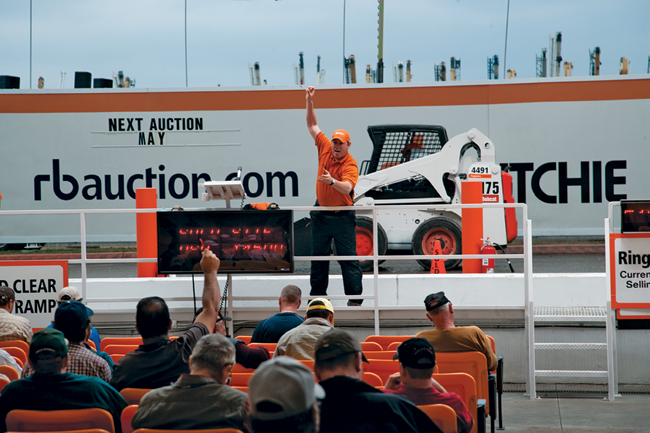
“The worldwide market for used equipment is massive, but highly fragmented. Analysts estimate that more than $100 billion of used equipment is bought and sold around the world each year,” says Olive. “Auctions represent a very small segment of that market; most people still sell their surplus equipment privately, by placing ads in magazines, on the internet or through other third-party methods. But our unreserved auctions offer significant benefits over those sales channels, which is one of the reasons for our continued success.”
Great prices, thorough inspection reports, access to transport and financing and a variety of choices, auctions offer an interesting and attractive alterative for small and large contractors. Skid steers, in particular, have become a popular used equipment category. An auction site like Ritchie Bros. or IronPlanet might have well over 100 used skid steers selling on any single day. There are still, of course, many reasons to buy a new skid steer, including warranty, tax benefits, the latest features and emission compliance technology, but if you can find a stout, low-hour used machine, the price point can be an enormous advantage to your pocketbook.
“Generally speaking, late model, low-hour skid steers might be expected to go for 25 to 40 percent less than new when bought at auction currently — that’s premium brands with good specs,” says Paul Hendrix, equipment pricing analyst for IronPlanet (the world’s leading online auction company for used construction and agricultural equipment). “That market has been hit particularly hard in the economic downturn due to high inventories for rentals and a high number of brands in the market, and their use — many are used in housing related industries and housing is the worst segment of the economy.”
In 2010, there are plenty of pre-owned skid steers on the market, but first you must educate yourself on how auctions work and how to evaluate and determine a good piece of used machinery. Pouring over maintenance records, doing visual inspections and investigating the brand and buyer, a clever contractor can have the tools to find a great deal.
“Look for a reputable brand from a well-established manufacturer. You’ll find much better availability of parts and service for these machines,” explains Curtis Goettel, marketing manager with Case Construction Equipment (manufacturing skid steers for more than 40 years, building its 250,000th unit in 2010).
“Depending on the age of the machine, you may find some original warranty remaining on it. In evaluating a used machine, a contractor should look at the hydraulic system and engine for possible leaks. Also, consider the optional equipment that’s on a used machine — it can add considerably to the machine’s value. You’ll need to be meticulous and thorough to the find the right unit.”
The Market for Skid Steer Auctions
North America has about 14 strong brands of skid steers and track loaders (the compact cousin that uses tracks instead of wheels) — Bobcat, Caterpillar, Gehl, Mustang, New Holland, Case, Komatsu, Terex-ASV, Volvo, JCB, John Deere, Rayco, Takeuchi and Thomas Equipment. Traditionally, skid steers would sell 50,000 to 65,000 new units a year, making it the American choice for compact loaders and tool carriers. But when we surveyed manufacturers back in January (“A Year to Reload,” page 20), companies noted an enormous drop in sales numbers over the last two years — in 2009 around 22,000 new skid steers were sold and 9,500 new track loaders, with expectations of a flat market for 2010. That means a lot of professionals are sticking with old equipment or are looking for attractive buys at used venues like an auction.
“In 2009, more than 5,200 used and unused skid steers were sold at Ritchie Bros. auctions,” says Olive. “Over the last five years, the number of skid steers sold at our auctions, regardless of used or unused, has increased. Numbers in 2009 remained relatively the same, but they began to pick up in the first half of 2010. Since 2005, the most popular skid steer loader model that was sold at our unreserved public auctions is the Bobcat 753 — with close to 900 of the Bobcat 753 sold at our unreserved public auctions since 2005.”
Companies like Ritchie Bros. usually sell both used and unused equipment (overstock inventory a dealer might call new) via the unreserved auction method — all equipment is sold “as is, where as” with no minimum bids, reserve prices or warranties. Sometimes auction houses will sell late-model or unused equipment that may still be covered by a manufacturer’s warranty. Live, unreserved public auctions often attract much larger crowds than any other type of auction — both online and at the auction event.
Bidders in the hundreds and thousands know that there are no hidden reserves, that every item will be sold to a new owner on auction day and that they will usually pay fair market value for their purchases.
Consequently, bid auctions are often an accurate barometer to the value of a machine. At a live event, auctioneers marshal the equipment in at a secure auction site, so customers can inspect, test and compare a diverse selection of makes, models and years from different sellers. Customers don’t have to rely on a third-party inspection report. They can trust their own eyes, kick the tires and verify the condition and value of a machine themselves (hey, bring your mechanic).
If it’s not up to snuff, some venues will even offer onsite refurbishment services.
“Our customers choose refurbishing facilities to repair or refurbish their skid steers and any other piece of equipment in their fleet before or after the auction and any other time in between,” says Olive. “Our qualified appraisers inspect your equipment to determine if it needs any work and how much it will cost. Once our customer approves the quote, our trained personnel get to work with any minor repairs, including glasswork, upholstery, welding, metalwork and minor mechanical repairs. Following any repairs or replacements, we give the equipment a thorough interior cleaning and remove all exterior dirt, grime and loose paint with industrial pressure washers. We also prepare the surface of the equipment before painting by masking and then sandblasting down to bare metal. Painting and decal replacement are the two final stages of the process.”
While Ritchie Bros. offers both live and online tools to find used equipment, companies like IronPlanet are selling a complete stay-at-home package to purchasing used equipment. Create a profile, navigate through various tabs and learn how to buy and sell on the internet. At IronPlanet, unreserved auctions happen every Thursday (where everything sells on that day) and then it also has Daily Marketplace running for one week intervals (where owners can put a reserve on equipment). For quality control purposes (since a buyer can’t inspect the skid steer themselves), IronPlanet inspects the equipment and offers its IronClad Assurance, which guarantees that the equipment received after the sale is the same equipment that was reported in the inspection report.
“It does not certify the equipment, but it is our guarantee that the equipment you see in the auction is the equipment that you receive after the sale,” explains Hendrix. “Before the equipment goes up for auction, we have a team of experienced inspectors who thoroughly process, test and inspect every aspect of the equipment from a visual inspection of key systems and components and ratings, wear-related measurements and oil and fluid samples when appropriate. The detailed reports also provide notes and images of the equipment and the inspection process. Once the reports are complete, they are posted on our website in advance for potential bidders to review.”
The almost new and used equipment sold usually comes to auction for various reasons — over inventory, fleet management, liquidation of assets and downsizing. Besides auctions, rental companies, dealers and used sites are good places for pre-owned equipment. Web surfers should check out sites like the Used Equipment Network (www.usedequip.com) or the Equipment Trader (www.equipmenttraderonline.com), which will list 40,000 to 75,000 pieces of used farm and construction equipment for sale by used equipment dealers and owners daily. Big manufacturers like Caterpillar even offer Cat Certified Used Equipment at its dealerships, which include financing, extended service coverage, machine maintenance history, thorough inspections and the knowledge that the professionals who make these machines are rebuilding them.
Most folks start with the web. Undeniably, the internet has become the first step for researching any subject, including how to find and buy a used skid steer.
“The internet has become an important tool for anyone looking to buy or sell used equipment,” says Hendrix. “With today’s busy schedules, traveling to different auction venues is both expensive and time consuming. The internet puts all the information you can ever want at your fingertips. You can find the equipment you need, review the inspection reports and make and educated choice when bidding all from the comfort of your office or home.”
It’s all about research — arm yourself with knowledge — know the brands, the options and the resale values. Call dealers and rental houses and ask them which units are the most reliable. Review the inspection reports, if available. Call ahead of the auction and ask specific questions about where the machine came from and how it looks. Good auctioneers and sellers should try to make the buying process as easy as possible from start to finish. Once the auction is over, the auction site and seller should work with the buyers to help connect them with transportation and finance companies. Once the payment transaction is complete, the seller releases the equipment to the buyer’s transportation company. The buyer accepts delivery of the equipment while the seller receives his or her payment. Hopefully, all parties are satisfied.
Inspection and Purchase
Good finds are the result of vigorous research and inspection. Today, skid steers are categorized by rated operating capacity, calculated by considering 50 percent of the tipping load (tipping load is the capacity at which the rear wheels lift off level ground); compact track loaders are calculated at 35 percent of tipping load because of the their track undercarriage. Today, operating capacities for skid steers range from 600 to 3,700 lbs (track loaders range from 500 to 2,660 lbs). AEM recognizes nine classes of skid steers worldwide. Today, the most popular class is the 1,750- to 2,200-lb size machines (in the price range of $25,000 to $29,000).
“Generally, the cost difference between new and used skid steers is dependent on several factors,” says Mike Fitzgerald, loader product specialist with Bobcat Co. (inventors of the original skid steer in 1960). “Consider age, the number of hours on the machine, the physical condition of the machine and the application the machine was used in. For example, an older machine [more hours] that has been maintained properly may be worth more than a newer machine that has less age [fewer hours], but has been abused.”
Once you start investigating today’s skid steers and track loaders, you’ll notice they are much larger than their previous counterparts, engineered with longer wheelbases, bigger cabs and more powerful engines. The first 1000 Series skid steer from Mustang Mfg. barely boasted 30 hp. Today the largest Mustang skid steer — the 2109 — boasts a 99-hp diesel engine and a whopping SAE-rated operating capacity of 3,850 lbs.
Along with bigger and more powerful units come a variety of small- and medium-size skid steer models. Take Bobcat for instance, which has seven models of track loaders to choose from and 13 models of skid steers, including its tiny but tough subcompact S70 unit, which is only 6 ft tall and 3 ft wide — the ideal size for scooting through narrow doorways, corridors, alleys and gates.
Better hydraulic drive motors, hydraulic pumps and auxiliary hydraulics have given today’s machines more oil flow to operate larger loads and bigger attachments. Regular flow hydraulics for skid steers and track loaders range from 19 to 23 gpm, depending on the size and power of your unit. With high-flow hydraulics, you can get up to 40 gpm, able to run bigger and more efficient attachments — whether it’s a massive cold planer to strip asphalt or a serious stump grinder to remove old trees.
Sticking with the arms, you’ll find today’s skid steers and track loaders have two main types of lift arm configurations — radial and vertical lift. In a radial lift arm pattern, the arm pivots on one joint as it moves up, naturally radiating as the load arm is raised. Radial lift machines have traditionally been used as digging machines or tool carriers. Vertical lift style skid steers and track loaders specialize in load-and-carry operations, getting good lift capacity by keeping the load close to the machine while the lift arm of the loader rises.
“With the variety of machine sizes, horsepower and other performance variations, customers tend to purchase what fits their application or needs,” says Fitzgerald.
Try breaking down the used inspection process into four major categories: 1) Mechanical — engine, drivetrain and hydraulics; 2) Structural — booms, frames and loader arms; 3) Cosmetic — paint, interior and rust/corrosion; and 4) Tires and Undercarriage. If you look at each area individually, then it’s easier to identify problems and assess them in relation to their effect on value.
- During demos look for smoke, leaks and unusual noises, then check fluid levels and open all compartments and inspect.
- Inspect the condition of the loader arms (check for cracks and welds) and cylinder pivot pins.
- Consider the condition of the bucket, particularly the cutting edge.
- Check the condition of the canopy and grab handles (too much damage can reduce value). Also, look at the sheet metal condition.
- Check for A/C; many units show an A/C control when it is not installed.
- Look at tire and track condition. For a track loader, thoroughly inspect the wheels, rollers and sprockets of the undercarriage.
- Inspect hydraulic hoses, hydraulic controls, parking brake, battery and cables and lights if equipped.
- Inspect the cab, tugging on seat belts, steering controls and sitting in the seat. Play with the consoles and various gadgets and settings too.
- Eye the diesel engine thoroughly. Is starting easy or hard? Smoke/no smoke? Then check the hoses, belts, radiator, air cleaners, filters and oil level and appearance.
- Then get a feel for the transmission — noisy or quiet, smooth or rough, powerful or lagging?
Work order and maintenance records are useful pieces of information to evaluate prior to making a purchase. If you are shopping for a track loader, the undercarriage parts will be an ongoing cost and a big consideration, so know the price of components and the expected life of what you’re buying. In an ideal situation, learn about the operators and how the unit was used.
“Find out whether the previous owner was an owner-operator,” says Goettel. “Typically, an owner-operator takes good care of his equipment. Also, find out how the skid steer was used. If it was used in light-duty applications like loading and carrying mulch, it will have a lot more life left in it than if it’s been digging up concrete or pushing heavy material.”
It’s good to note that most parts are available for older skid steer loaders. The mechanical systems of the most models (new and old) are similar to what is currently being offered, therefore dealer technicians are able to diagnose and repair older machines as easily as they do newer machines. With the proper research and help, almost any buyer can find a good used or unused skid steer — just don’t be afraid to ask for help.
“The skid steer market is a very crowded and frankly confusing one — there are dozens of choices between brands and configurations so be sure to research who in your area can support the product at a level that you are comfortable with,” says Hendrix. “Ask about any major repairs, call a dealer in another region and ask about the general history of a particular model. Even call a competitive dealer to ask if there are any overall issues with a certain brand or model. Do the proper research and you can find your perfect pre-owned skid steer.”
Keith Gribbins is managing editor of Compact Equipment, based in Peninsula, Ohio.
Steering into Quality Maintenance
Curtis Goettel, Marketing Manager for Case, Gives Five Tips to Help Preserve Skid Loaders
Daily Maintenance Is the Key — Operators should be trained to check all fluid levels — especially hydraulic fluid and engine oil — and filters every day. Most skid steers provide easy access to fluid gauges and filters. Check the machine’s grease points every day. Most machines have about 10 to 15 points that need daily greasing. Inspect the radiator to make sure it’s not clogged with debris. The few minutes spent on daily maintenance can prevent costly downtime and can help extend the machine’s useful life.
- Follow the Manufacturer’s Recommendations — It should probably go without saying, but one of the best things you can do to ensure a long life for your skid steer is to follow the manufacturer’s guidelines for scheduled maintenance.
- Understand Your Operating Environment — In addition to following the manufacturer’s recommended maintenance procedures, owners should be aware of how their operating environment affects skid steer maintenance. For example, if you’re working in a hot and dusty environment, you’ll need to grease more frequently and closely monitor operating temperatures. Pay attention to any unusual sounds from the machine’s hydraulic system and pivot points. Those are audio cues for extra maintenance.
- Establish Good Habits — Establish good habits and follow them daily. This includes daily checks of fluids and filters and, most importantly, daily attention to the machine’s grease points. Additionally, it is always a good idea to wash and clean your machine regularly.
- Don’t Ask the Machine for More than It Can Do — With the right attachment, there’s not much you can’t do with a skid steer, as long as you stay within rated capacities and don’t ask the machine to do more than it can. Certain applications, like bulk commodity loading, require larger capacity machines. A new skid steer usually will stay on the job for about 5,000 hours before the original owner trades it in. A second owner may keep the machine running for another five to eight years at a reduced workload. It’s not uncommon for a skid steer to keep working for up to 20 years or longer on a more casual basis.

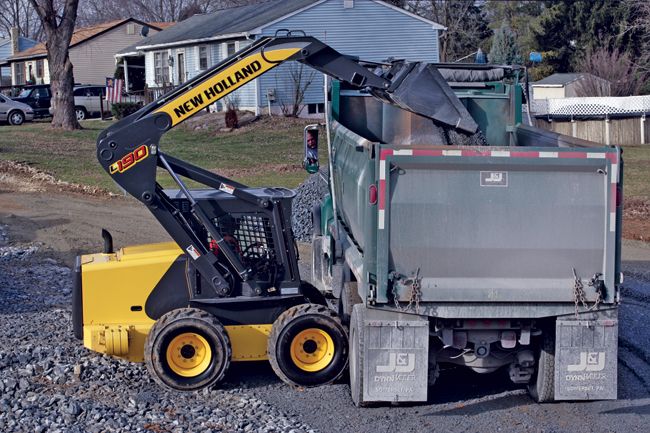
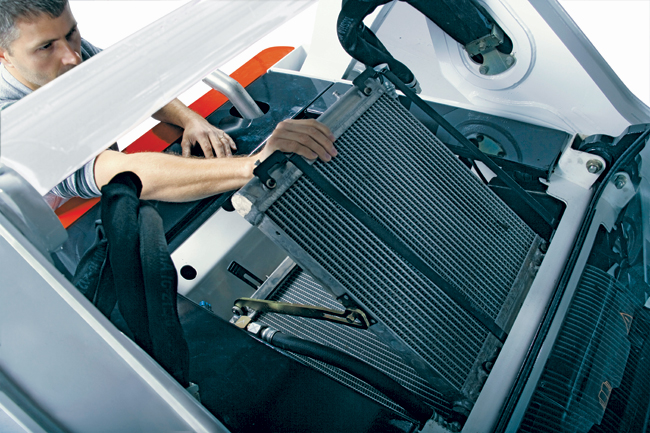
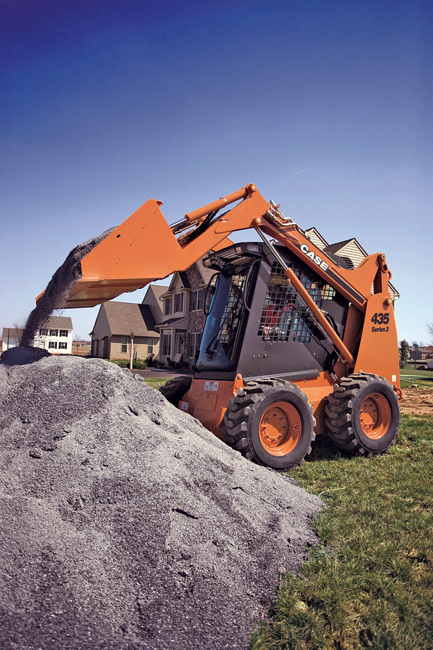 Daily Maintenance Is the Key — Operators should be trained to check all fluid levels — especially hydraulic fluid and engine oil — and filters every day. Most skid steers provide easy access to fluid gauges and filters. Check the machine’s grease points every day. Most machines have about 10 to 15 points that need daily greasing. Inspect the radiator to make sure it’s not clogged with debris. The few minutes spent on daily maintenance can prevent costly downtime and can help extend the machine’s useful life.
Daily Maintenance Is the Key — Operators should be trained to check all fluid levels — especially hydraulic fluid and engine oil — and filters every day. Most skid steers provide easy access to fluid gauges and filters. Check the machine’s grease points every day. Most machines have about 10 to 15 points that need daily greasing. Inspect the radiator to make sure it’s not clogged with debris. The few minutes spent on daily maintenance can prevent costly downtime and can help extend the machine’s useful life.


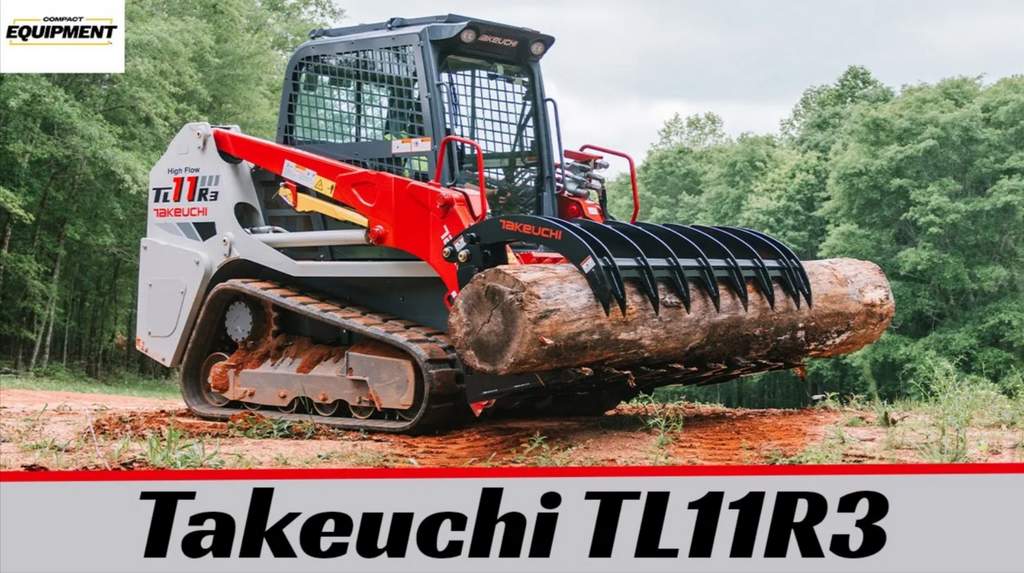
Comments are closed here.